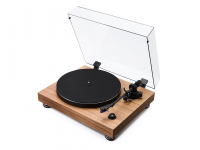
Elipson are the latest brand to hit the shelves here at Richer Sounds, but the French manufacturer has been in operation for over 50 years, predominantly as a designer and builder of unique loudspeakers. With its Omega 100 RIAA BT (not to be mistaken with the standard Omega 100), Elipson is aiming to bring its sense of style and engineering know-how to a turntable market that is as popular – and therefore as crowded – as it has been since its heyday. How will it fare?…
As mentioned above, Elipson is best known as a speaker manufacturer, and one that has always travelled a different path than their competitors. Indeed, a quick look at their range of current designs will show a brand that refuses to adhere to the standard design principles that make up 99% of speakers on the market. Instead they often favour spherical cabinets over the more traditional oblong boxes. This penchant for style and engineering sensibility can also be found in the ’100 RIAA. Right out of the box it’s clear that it’s a looker, with its curved base rising to meet a beautifully finished glossy plinth. The lush visuals don’t stop there, though. Elipson have fitted a smart-looking straight tonearm, a thin platter made from pressed steel, and a neat little switch to control speeds – with both 33 1/3 and 45 RPM records catered for. In a similar setup to Project turntables, the Elipson is belt driven; with the belt sitting around the outside of the platter, attaching to a small cog in the upper left hand corner of the plinth. If looks were the sole consideration when picking a turntable, the ‘100 RIAA would be a worthwhile recommendation from the off.
We noted earlier that the ’100 RIAA has a stable mate with a similar name. This standard version of the Omega 100 lacks some of the features seen here, and we think these additions are definitely worthwhile. First of all there’s the BT side of the model number. No prizes for guessing that it means Bluetooth! A clever way of modernising the vinyl listening process, Bluetooth’s inclusion allows the ’100 RIAA to send its signal wirelessly to compatible Bluetooth speakers or hi-fi systems, ditching the need for cabling between the two devices.
Sticking with the theme of modernity, ’100 RIAA also has a USB output, offering users a way to archive their record collection directly to a PC or MAC. While this has been a feature that has increased in popularity over the past few years, it’s always nice to see it pop up on spec sheets with new models. A built-in phono stage also ensures that connectivity with any regular hi-fi amplifier is straightforward.
Yet another clever technology the Elipson utilises is Digital Sinusoidal Signal (DSS) synthesis. Not just a very snazzy name, DSS allows for state-of-the-art speed and stability control, ensuring that the ’100 RIAA has brilliant accuracy and precision during playback.
That tasty looking tonearm is also very much worth a mention. Using an “orbital” structure in its design, the supplied arm offers class-leading levels of precision. Anti-skating and weight are adjustable, which is handy if you’re planning to change cartridge. Not that there’s much need for that! An Ortofon OM10 cartridge is fitted as standard, and given that this is one of the best options at its price point, you’re off to a flying start just by sticking with what’s already available.

The supplied Ortofon OM10 in action
During the course of listening we tried the ’100 RIAA with both a traditional hi-fi system (the Cambridge CXA80 amplifier and Focal Aria 905 bookshelf speakers) and also to a number of Bluetooth speakers, really just as a test to see how things held up in this regard. The good news is that if you’re planning to investigate the ’100 RIAA for this purpose alone, Bluetooth is by far from a gimmick, with the Elipson easy to connect to compatible speakers and giving a generally solid performance. The quality of the speaker or system that you connect to will obviously play a large part in this, with something like Naim’s Mu-So or Mu-So Qb proving to be fantastic partners.
Wired into our separates system, the real listening was under way, and the Elipson was happily giving all other turntable contenders a run for their money. Seeing how it could deal with both micro and macro detail would give us an idea of where it sat in relation to something like Sony’s PSHX500 or Project’s Debut Carbon Esprit SB. Opting for Aphex Twin’s Syro LP, the ’100 RIAA got straight down to business, revealing all of the intricacies of opener ‘Minipops 67 [120.2]’ brilliantly. Whilst not as intensely layered as some of his earlier work, Syro is a superbly produced work, and a good quality setup can really make it sound excellent. The levels of detail, matched with excellent timing and control, made for a great listen. The lower frequencies in particular were top notch, with punch and depth on display in equal measure.
This penchant for detail retrieval and solid bass performance were the ’100 RIAA’s strongest traits, making themselves known throughout all of our listening session. This was, of course, great news; offering us the best of both worlds – a turntable that focuses on both musical enjoyment and presenting the facts in equal measure. It makes for a fantastic alternative to Project’s range of award-winners, and brings a number of unique technologies to the party, too. An easy recommendation!
To find out more about our full range of turnables, call or visit your local store!
For more information on the Elipson Omega 100 Riaa BT Turntable, click here.
Author: Chris, Liverpool store





